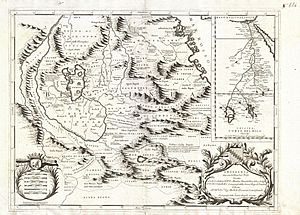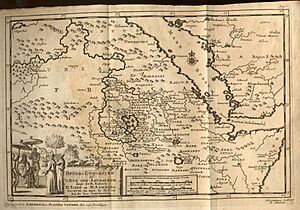Jerónimo Lobo facts for kids
Quick facts for kids
Jerónimo Lobo
|
|
|---|---|
| Born | 1595 |
| Died | 29 January 1678 (aged 82–83) |
| Occupation | Jesuit missionary, writer |
| Parent(s) | Francisco Lobo da Gama Maria Brandão de Vasconcelos |
Jerónimo Lobo (born in 1595, died in 1678) was a Portuguese Jesuit missionary. He was part of a group trying to change Ethiopia's main church, the Ethiopian Orthodox Tewahedo Church, to Roman Catholicism. This effort didn't succeed, and the Jesuits were sent away from Ethiopia in 1643. After his time there, he wrote a book called Itinerário. This book is a very important source of information about Ethiopia's history and culture.
Contents
Jerónimo Lobo's Life and Travels
Jerónimo Lobo was born in Lisbon, Portugal. He was one of many children. His father, Francisco Lobo da Gama, was the Governor of Portuguese Cape Verde. When Jerónimo was 14, he joined the Society of Jesus, also known as the Jesuits.
In 1621, he became a priest. He was then sent as a missionary to India. In 1622, his ship was attacked by English and Dutch ships near Portuguese Mozambique. He survived and arrived in Goa, India, in December 1622.
Journey to Ethiopia
Jerónimo Lobo wanted to go to Ethiopia. The Emperor of Ethiopia, Susenyos I, had recently become a Catholic. So, Lobo left India in 1624. It was hard to reach Ethiopia because the country didn't control its northern coast.
First, he landed in Pate. He tried to travel along the Jubba River through land controlled by the Oromo people. But he had to turn back.
In 1625, he tried again. This time, he traveled with Afonso Mendes, who was the Catholic leader for Ethiopia. They also had eight other missionaries. They landed at Beilul, a port on the Red Sea. This port was controlled by the king of Dankali, who was a ruler under the Ethiopian Emperor.
After crossing the desert for a month, they reached Fremona. There, Lobo became the leader of the missions in the Tigray region.
Important Work in Ethiopia
While in Ethiopia, Jerónimo Lobo did several important things. He helped find the remains of Cristóvão da Gama. Cristóvão da Gama was a Portuguese explorer who had been captured and killed in 1542. Lobo found his remains at the request of Cristóvão's great-nephew.
Lobo also worked as a missionary in the area southwest of Lake Tana. In 1629, he visited the source of the Blue Nile river.
Challenges and Return
In 1632, Emperor Susenyos stepped down from power. His son, Fasilides, became the new emperor. Fasilides was not friendly to the Catholics. He first kept them at Fremona. Then, in 1634, Lobo and his friends were forced to leave Ethiopia.
On their journey, they faced many dangers. Local people robbed and attacked them. They finally reached the Ottoman leader in Massawa. This leader sent them to his boss in Suakin. There, the Pasha (a high-ranking official) made them pay a large sum of money to be set free.
Lobo borrowed money from local merchants to pay the ransom. But at the last minute, the Pasha kept Patriarch Mendes and three other priests. He wanted even more money for them.
Once Lobo reached Diu, he traveled to Goa. He arrived there in December 1634. He tried to convince the Portuguese viceroy to send ships to the Red Sea. Lobo wanted them to capture Suakin and Massawa. He hoped this would free the Patriarch and bring Catholicism back to Ethiopia.
The viceroy was willing to send a small force to free the Patriarch. But he didn't want to keep Portuguese soldiers in those ports. Lobo wanted more than just freeing the Patriarch. So, he sailed back to Portugal. On his way, his ship crashed near Natal, and he was captured by pirates.
He eventually arrived in Lisbon. He tried to get support for his plan in Lisbon, Madrid, and Rome. But no one approved his idea.
He returned to India in 1640. He became a leader for the Jesuits in Goa. After some years, he went back to his hometown of Lisbon, where he passed away.
Jerónimo Lobo's Writings
Jerónimo Lobo wrote several important texts. He exchanged letters with Henry Oldenburg of the Royal Society. They discussed the source of the Nile River. This likely led to a small book being published in London. It was called A Short Relation of the River Nile. It described the Nile's source and how it flowed.
Other short writings by Lobo were found in libraries. One was called Breve Notícia e Relação de Algumas Cousas Certas não vulgares. It talked about similar topics as A Short Relation.
His most famous work is his memoirs, called Itinerário. This book covers his journey to India, his time in Ethiopia, and his trip back to Portugal. However, Itinerário was not published while he was alive.
Baltasar Teles used a lot of Lobo's writings in his book, História geral da Ethiópia a Alta (1660). People often mistakenly thought Lobo wrote this book.
Lobo's own story was translated into French in 1728 by Joachim le Grand. It was titled Voyage historique d'Abissinie. Later, a shorter English version of Le Grand's book was published in 1735 by Dr. Samuel Johnson.
In 1947, another copy of Lobo's work was found in a library in Braga, Portugal. This was not the same copy that Le Grand translated. Both were copies of Lobo's original writings. This full manuscript was translated into English by Donald M. Lockhart and published in 1984.



